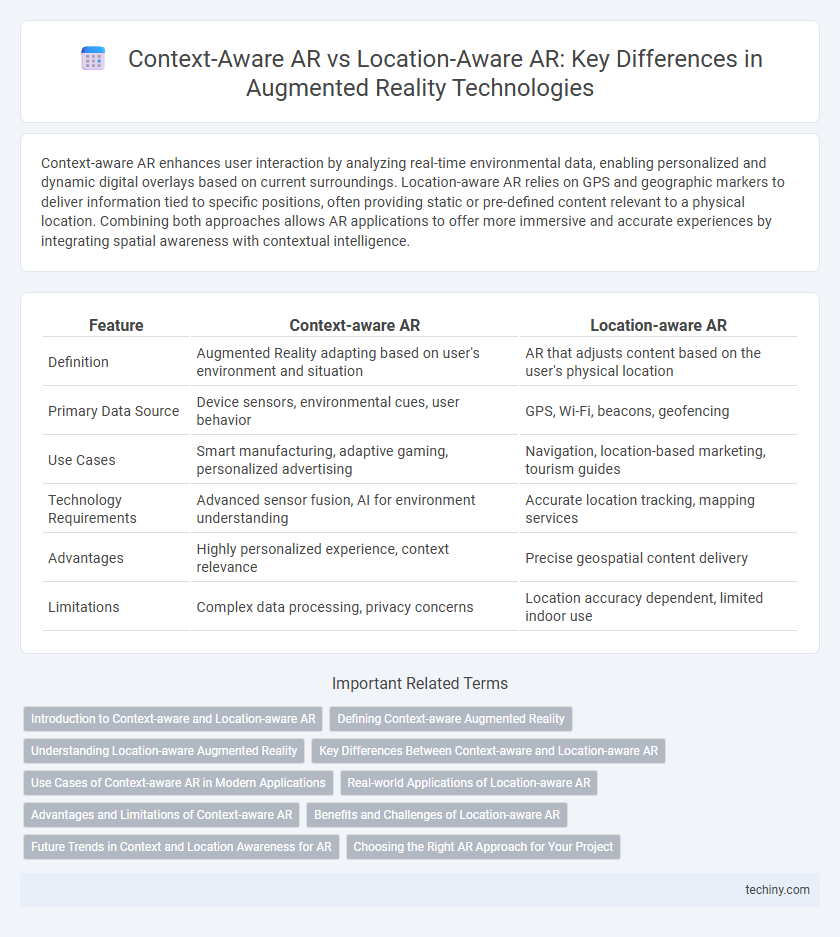Context-aware AR enhances user interaction by analyzing real-time environmental data, enabling personalized and dynamic digital overlays based on current surroundings. Location-aware AR relies on GPS and geographic markers to deliver information tied to specific positions, often providing static or pre-defined content relevant to a physical location. Combining both approaches allows AR applications to offer more immersive and accurate experiences by integrating spatial awareness with contextual intelligence.
Table of Comparison
| Feature | Context-aware AR | Location-aware AR |
|---|---|---|
| Definition | Augmented Reality adapting based on user's environment and situation | AR that adjusts content based on the user's physical location |
| Primary Data Source | Device sensors, environmental cues, user behavior | GPS, Wi-Fi, beacons, geofencing |
| Use Cases | Smart manufacturing, adaptive gaming, personalized advertising | Navigation, location-based marketing, tourism guides |
| Technology Requirements | Advanced sensor fusion, AI for environment understanding | Accurate location tracking, mapping services |
| Advantages | Highly personalized experience, context relevance | Precise geospatial content delivery |
| Limitations | Complex data processing, privacy concerns | Location accuracy dependent, limited indoor use |
Introduction to Context-aware and Location-aware AR
Context-aware augmented reality adapts digital content based on a user's environmental factors such as time, user activity, and nearby objects, creating highly personalized experiences. Location-aware augmented reality relies primarily on GPS, compass, and mapping data to overlay information anchored to specific geographic coordinates. Both approaches enhance AR applications by integrating real-world context, but context-aware AR offers dynamic interaction beyond geographical positioning.
Defining Context-aware Augmented Reality
Context-aware augmented reality (AR) enhances user experiences by dynamically adapting digital content based on real-time environmental factors such as object recognition, user behavior, and situational context. Unlike location-aware AR, which relies primarily on GPS coordinates to trigger content, context-aware AR integrates sensor data, machine learning, and computer vision to provide more personalized and relevant interactions. This intelligent system not only identifies the physical surroundings but also interprets user intent, creating immersive and situationally appropriate AR experiences.
Understanding Location-aware Augmented Reality
Location-aware augmented reality (AR) leverages GPS, accelerometer, and compass data to anchor digital content to specific physical locations, enabling users to experience context-specific interactions based on their geographic position. This technology enhances navigation, tourism, and retail by overlaying virtual information onto the real world precisely where it matters. Unlike context-aware AR, which interprets complex environmental cues and user behavior, location-aware AR relies primarily on spatial coordinates to deliver relevant augmented experiences.
Key Differences Between Context-aware and Location-aware AR
Context-aware AR dynamically adapts digital content based on real-time environmental factors such as object recognition, user behavior, and surrounding conditions, providing personalized and interactive experiences. Location-aware AR relies primarily on GPS, compass, and mapping data to overlay information tied to specific geographic coordinates, making it ideal for navigation and place-based applications. The key difference lies in context-aware AR's ability to interpret and respond to immediate environmental cues versus location-aware AR's focus on fixed spatial positioning.
Use Cases of Context-aware AR in Modern Applications
Context-aware AR enhances user interaction by detecting environmental factors such as lighting, objects, and user behavior, enabling personalized experiences in retail, healthcare, and education. In modern applications, it allows virtual try-ons that adjust to real-time conditions, supports surgeons with dynamic, patient-specific overlays during operations, and fosters immersive learning by adapting content based on student engagement and surroundings. These use cases demonstrate context-aware AR's capability to deliver responsive, intelligent augmentation beyond fixed geographic constraints found in location-aware AR.
Real-world Applications of Location-aware AR
Location-aware AR leverages GPS, accelerometers, and digital compasses to overlay digital content based on users' geographic locations, making it ideal for navigation, tourism, and retail. Real-world applications include AR-enabled city tours that provide historical information as users explore landmarks, and retail apps displaying product details and promotions when customers are near specific store sections. This technology enhances user engagement by delivering contextually relevant information tied directly to physical surroundings.
Advantages and Limitations of Context-aware AR
Context-aware AR leverages real-time environmental data and user context, offering highly personalized and interactive experiences compared to location-aware AR, which relies primarily on GPS coordinates. Its advantages include enhanced accuracy in object recognition, better adaptation to dynamic surroundings, and improved user engagement through contextually relevant content. Limitations involve higher computational requirements, dependence on sensor reliability, and potential privacy concerns due to continuous context data collection.
Benefits and Challenges of Location-aware AR
Location-aware AR leverages GPS and geospatial data to provide immersive, real-world contextual experiences by overlaying digital information relevant to a user's physical location, enhancing navigation, tourism, and outdoor gaming. The benefits include precise environment mapping and tailored content delivery based on exact coordinates, promoting user engagement and meaningful interaction with surroundings. Challenges involve GPS inaccuracies, signal obstructions, and high energy consumption, which can degrade the AR experience in dense urban areas or indoors, necessitating advanced sensor fusion and optimization techniques.
Future Trends in Context and Location Awareness for AR
Future trends in context-aware AR emphasize enhanced semantic understanding through advanced AI, enabling devices to interpret and respond to user intent and environment dynamically. Location-aware AR will benefit from improvements in spatial mapping technologies and 5G connectivity, delivering precise geospatial data and seamless real-time interactions. Integrating both context and location awareness promises richer, more immersive AR experiences by combining environmental understanding with accurate positioning.
Choosing the Right AR Approach for Your Project
Context-aware AR utilizes environmental data and user interactions to deliver dynamic, personalized experiences, making it ideal for projects requiring real-time adaptability and complex user engagement. Location-aware AR relies on GPS coordinates and geographic data, providing location-specific overlays best suited for outdoor navigation, tourism, or site-specific marketing. Selecting the right AR approach depends on project goals, user context, and the desired level of interaction, ensuring optimal functionality and user experience.
Context-aware AR vs Location-aware AR Infographic

 techiny.com
techiny.com